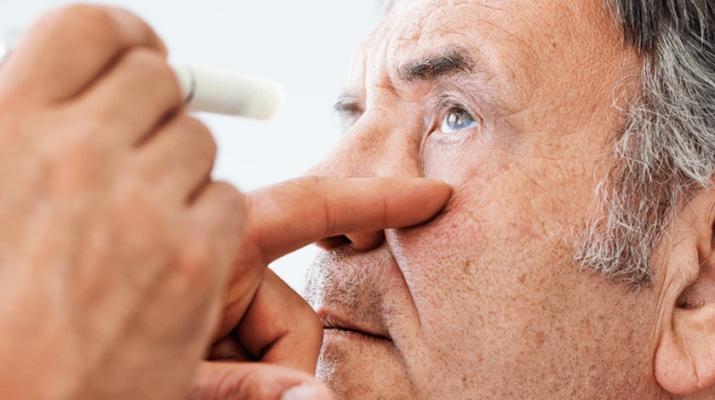Droopy eyelids, dry eyes, floaters, cataracts, ocular migraines are just some of the eye problems we may have to deal with as we age
By Deborah Jeanne Sergeant
As you begin to “play trombone” with your reading materials to get them in focus, it becomes apparent you may need reading glasses. Most people require correction for presbyopia — short distance vision — around their mid-40s to early 50s. While an unwelcomed sign of aging, it’s easily corrected with drugstore “cheater” glasses.
Less common are other changes in vision related to aging. Some are more serious than others.
Droopy eyelids may affect vision as one ages.
“The eyelids may feel heavier and crepey,” said Rajeev Ramchandran, associate professor of ophthalmology, public health sciences, at the Center for Community Health and Prevention at Flaum Eye Institute. “In the front of the eye as you get older, you get more wrinkles. You start getting brow aches from having to lift your brow up.”
As the lid droops, it can block vision. An evaluation can help determine if a surgical approach could remedy the problem.
Dry eyes can also cause vision issues for older adults. It may feel like a foreign body is in the eye or that the eye tears a lot. Ramchandran said that the lipid layers may not be as present.
“You may not be taking in as much water as you used to,” he said. “The intake of liquid may also be affecting your tears.”
The eyelid also may not close as well as it used to, which can cause tears to leak and the eye to water more. Or a duct in the lower lid may be locked. Ramchandran recommends using non-tearing baby shampoo on a warm washcloth to clean away any build-up.
Slowly, over time, cataracts can develop. The vision becomes dim and more yellow in tone and night driving becomes very difficult. The lens, which sits behind the iris, becomes cloudy. Exposure to UV light, diabetes and certain medication can hasten the otherwise age-related condition. With a 10-minute, outpatient surgery, doctors can replace the lens with an artificial lens.
Behind the lens, there’s the vitreous jelly.
“It’s mostly made of collagen and water,” Ramchandran said. “Just as you have breakdown in the skin, you have breakdown in the collagen of the eye. That can result in some more mobility of the jelly and also the condensation you see as ‘floaters’ which are common. For someone who’s nearsighted, they get floaters sooner.”
He said that having a few floaters shouldn’t concern anyone, but a sudden increase or very large numbers of floaters or seeing “flashing lights” can indicate that the jelly is pulling hard enough to cause retinal tear. Retinal detachment can cause permanent blindness, so anyone experiencing these symptoms should seek immediate medical care.
As should anyone experiencing sudden loss of vision, loss of a portion of vision or persistent blurring.
Some people who have ocular migraines suffer temporary vision loss that returns right away; however, people losing vision without history of migraines should seek prompt care.
People with family history of macular degeneration or cigarette smoking are more likely to develop the condition.
“That’s something you won’t have any signs necessarily, but if suddenly straight things look wavy it could indicate you have something going on in the center of your vision,” Ramchandran said.
Family history also plays a role in glaucoma, which is damage to the optic nerve. Usually, loss of the peripheral vision indicates onset. The lost vision cannot be restored.
Stroke can also affect the retina and optic nerve.
“If you have any pieces of your vision that you’re losing, those are signs you really need to get checked out,” Ramchandran said.
Kerstin Abreau, doctor of ophthalmology at The Eye Care Center in Geneva, Canandaigua, and Newark, also said to seek immediate medical attention for symptoms such as “flashes of light, an increase in floaters, a black curtain coming across your vision, loss of vision in one or both eyes, or double vision.”
If your regular provider cannot see you, you may need to go to the emergency room.
“Please, do not wait to see if your symptoms go away on their own as this may result in permanent damage,” Abreau said.
She recommends that people 60 an older visit their vision care provider annually to ensure that changes in vision are normal. Diseases like glaucoma and macular degeneration are more common with older age. People with eye conditions may need more frequent eye exams.

